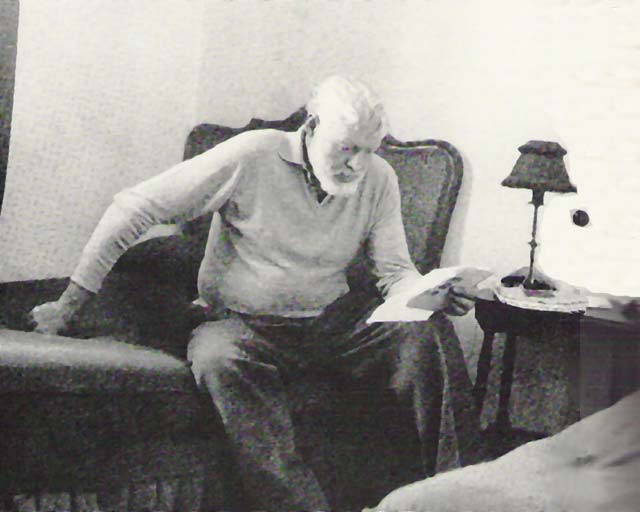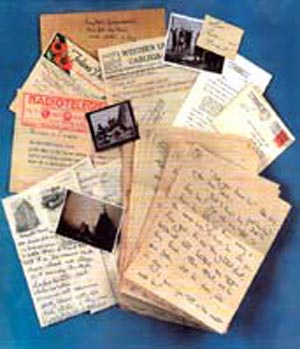His Ambiguous, Bi-Polar Style
In Writing as in LifeAs you get older it is harder to have heroes, but it is sort of necessary. - Ernest Hemingway
Older Hemingway
Ernest Hemingway’s extraordinary talent seems to lie mainly in his ability to write in such an ambiguous (one might even say bipolar) style, that each reader can find the meaning he desires. This skill is aptly demonstrated in "The Short Happy Life of Francis Macomber", written two years after Hemingway’s return from an African safari. This rather longish short story manages to incorporate characters and meaning so unclear that Hemingway scholars more than 5 decades later cannot agree on what the characters represent, what (if any) insight the characters achieved, who (if anyone) was the protagonist, who served as models for the characters, where the idea for the plot came from, nor how to interpret Ernest’s remarks about this story uttered many years later. The passage of time appears to have added to the mystique - or the confusion, if you prefer. The story, set in Africa, concerns 3 main characters: husband and wife Francis and Margot Macomber and their hired hunting guide, Robert Wilson. Francis is a wealthy American sportsman, good-looking, though lacking in courage. Margot is lovely but fading and known to have been unfaithful to Francis in the past. Wilson is weathered, with "cold blue eyes." Francis loses his nerve when confronted by a charging lion. Margot retaliates by sleeping with Wilson. The next day, Francis overcomes his fear and faces a charging buffalo; he shoots it several times, but ineffectively. Margot, waiting in the car, attempts to shoot the buffalo before it reaches Francis. However, she misses and shoots her husband in the head, killing him instantly. Wilson successfully kills the buffalo before it reaches Macomber’s body, so Margot’s "help" was unnecessary. Wilson accuses her of deliberately killing her husband because, he says, she feared that Francis, utilising his new-found courage, might finally leave her. Wilson taunts Margot until she begs him to stop. The major ambiguities in characterisation seem to be Did Francis really undergo a permanent positive change in his sudden acquisition of courage? Was Margot an unrelenting bitch who always acted selfishly, or was she a subtly-drawn tragic figure? Was Wilson a hero or a fool? Wilson quotes a line from Shakespeare: "By my troth, I care not; a man can die but once; we owe god a death [...] and let it go which way it will, he that dies this year is quit for the next" (2 Henry IV 3.2.216). According to Paul Smith writing in "A Partial Review", the interpretation of this line more-or-less neatly divides the traditionalists from the revisionists. For the former, "...the line is, as Wilson says, ‘damned fine’" (386). Carlos Baker, writing in Hemingway: The Writer as Artist, says it was "a kind of tribute to Macomber’s own lack of fear on the second day" (190). The revisionists point out that the line was originally spoken by a fool named Francis Feeble. According to "The Short Happy Life of Macomber," by Virgil Hutton, "the fool is neither Shakespeare nor Hemingway but Robert Wilson" (243). When he refused to hunt buffalo with Macomber in thick cover, Wilson contradicted the philosophy he stated by demonstrating a clear desire to avoid death this year. The story’s moral is as ambiguous as its characters. According to Sheldon Norman Grebstein writing in Hemingway’s Craft, a true man must always have the upper hand over a woman, "if he is to enjoy the happy life proper to the authentic male. That is one of the story’s basic messages" (85). Later, Grebstein states that the story’s basic theme is "the miracle of manly courage" (104). Philip Young, in Ernest Hemingway: A Reconsideration, says that Margot shot Francis "’by mistake on purpose’" (73). Grebstein, however, says such an interpretation "ignores the text and superimposes the critic’s ingenuity upon the conventions of narrative perspective" (85). Young feels that Wilson is the hero (74) whereas Hutton characterises Wilson as hypocritical and cruel, a man who "fails as a moral guide" and "is not even a competent hunting guide" ("Short Happy Life" 239, 242, 244). Hutton feels Margot is "the central [...] figure in this tragedy of ignorance and misunderstandings" (250). Some critics even feel Wilson was callously pleased about the shooting as it allowed him to protect himself against Margot, who might otherwise have been tempted to reveal his illegal car chase to the authorities. Writing in Reconsideration, Young states that while he believes that Francis is "not the hero" (74), he nevertheless feels Macomber may be based on Hemingway himself (71, 73). Conversely, many scholars and critics have assumed the Macombers were based on Hemingway friends F[rancis] Scott Fitzgerald and his wife, Zelda. Jeffrey Meyers, in "Wallace Stevens and ‘The Short Happy Life of Francis Macomber’", suggests Francis incorporates the character of poet Wallace Stevens, based on a real-life event wherein Stevens begged Hemingway not to talk about the outcome of a fight the two men had (which Stevens lost) (47 - 48). However, most scholars seem to agree that the Macombers were based on long-time family friend (and possible intimate Hemingway acquaintance) Jane Mason and her husband Grant. Bernice Kert, writing in The Hemingway Women, says, "As his ambiguous relationship with Jane was coming to an end, Ernest created a female character whose prototype - or so he confided to some of his Cuban friends - was the woman they all knew as Jane Mason" (274 - 75). Carlos Baker, writing in Ernest Hemingway, says Hemingway told Arnold Gingrich (Jane Mason’s fourth husband) that Jane was flattered when people said she was the model for Margot Macomber (299) but Denis Brian, writing in The True Gen, quotes Gingrich as having said only "he told me people were flattered to be portrayed in works of fiction" (84). Some scholars even feel that Margot was based on Hemingway’s wife, Pauline. Robert Wilson is often considered to be based on either Hemingway’s real-life safari guide, Philip Percival or else on the safari guide Jane Mason hired two years later, Bror von Blixen. What was the origin for the "Macomber" plot? Guide Philip Percival often entertained his clients with campfire tales. One was about the mysterious death of a man on safari. The dead man’s wife and the guide in Percival’s tale had been having an affair. Both were suspected of murder but were later acquitted and the death ruled a suicide. In "Patterson and the Blyths", Kenneth Cameron provides detail. Cameron says the story was notorious and true, and feels the character of Robert Wilson was actually based on the guide in that story, a man named J H Patterson. Patterson produced an autobiographical work called In the Grip of the Nyika, which, Cameron says, "concerns the death on safari of James Audley Blyth, son of Lord Blyth, and the return to Nairobi of Patterson and Mrs Effie Blyth some weeks later" (52). It seems that Patterson had stolen the position of senior game warden from Philip Percival’s older brother, Blayney Percival, so the tale was of special interest to Philip (although Blayney was re-hired when the scandal forced Patterson to resign) (52 - 56). Further, on a safari which they took with him around 1930, Philip Percival recounted still another tale to writers William and Irene Morden. This new story also contained details strikingly similar to "Macomber"; it seems Percival surely told Hemingway both tales. In this later story, Philip Percival himself was the hired guide of a wealthy American on his first safari; the American froze while being charged by a buffalo, which Percival managed to kill at the very last instant (Blythe and Sweet, "The Real Philip Percival" 78). Baker, in Hemingway: The Writer as Artist, writes, "The undeveloped germ of ‘Francis Macomber’ may have been the occasion when Hemingway and [his gun bearer] entered a bush-covered area in pursuit of a lion they heard but never saw [...] however, most of the other circumstances of the story were invented" (191-92). Young contends the story is a psychological reworking of the story Stephen Crane told in The Red Badge of Courage. Crane’s soldier hero faced danger with fear and fled. But the next time he faced the enemy, he awoke from a trance-like state to find his fear gone, "his manhood attained" (Reconsideration 198).
What did Hemingway himself say about the ambiguities in "Macomber"? He said nothing at all for many years. Then, in 1958, he asserted that he had known Margot Macomber very well in real life. "I invented her complete with handles from the worst bitch I knew (then) and when I first knew her she’d been lovely. Not my dish, not my pigeon, not my cup of tea, but lovely for what she was and I was her all of the above which is whatever you make of it." Baker says Hemingway acknowledged "many years later that he had drawn his portrait of Francis Macomber from a wealthy young international sportsman - a ‘nice jerk’ whom he had known very well in real life. ‘He is just how he really was,’ said Ernest ambiguously, ‘only he is invented’" (Ernest Hemingway 284). But how reliable was Hemingway? Baker says that Ernest told him he had disguised Percival-as-Wilson slightly "for family and business reasons" and to keep him out of trouble with the African authorities. Yet Percival stated he had told Ernest no names (284-85). Depending on which (if either) of Percival’s stories Ernest incorporated, the hunter could have been based on Percival or on Patterson. Finally, Alane Salierno Mason, Jane Mason’s granddaughter, writing in the Boston Review in February/March 2001, revealed that Jane Mason’s effects after her death turned up the original draft to "Macomber" along with penciled-in personal comments from Hemingway that strongly suggested Robert Wilson was likely Richard Cooper, the white hunter in Africa with whom Jane had been in love at the time. Hemingway, on the other hand, appeared to have been in love with Jane - an apparently unrequited love. Hemingway had originally called his story to Jane "A Comedy with Animals" and it appears, perhaps, to have been something of a private joke between them. Perhaps the answers to the questions about "Macomber", now that the actual people involved are all dead, no longer matter. Perhaps they never really mattered. Regardless of the actual answers (if such exist), Hemingway’s story forces the reader to examine and re-examine his or her expectations and suppositions. And this is literary writing at its best. Works Cited
BibliographyHemingway, Ernest. "The Short Happy Life of Francis Macomber." Cosmopolitan (Sep 1936). Rpt. in Perrine’s Literature: Structure, Sound and Sense. 8th ed. Ed. Thomas R. Arp and Greg Johnson. Fort Worth: Harcourt, 2001. 77-105.
For more articles, tests, film studies and visual amusements click the "Up" button below to take you to the Table of Contents for this Intellectual and Entertaining section. |
 Animals
Animals Animation
Animation Art of Playing Cards
Art of Playing Cards Drugs
Drugs Education
Education Environment
Environment Flying
Flying History
History Humour
Humour Immigration
Immigration Info/Tech
Info/Tech Intellectual/Entertaining
Intellectual/Entertaining Lifestyles
Lifestyles Men
Men Money/Politics/Law
Money/Politics/Law New Jersey
New Jersey Odds and Oddities
Odds and Oddities Older & Under
Older & Under Photography
Photography Prisons
Prisons Relationships
Relationships Science
Science Social/Cultural
Social/Cultural Terrorism
Terrorism Wellington
Wellington Working
Working Zero Return Investment
Zero Return Investment
